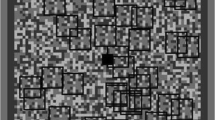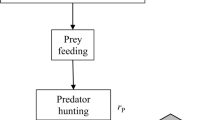Abstract
Aggregation is a well documented behaviour in a number of animal groups. The “confusion effect” is one mechanism thought to mitigate the success of predators feeding on gregarious prey and hence favour aggregation. An artificial neural network model of prey targeting is developed to explore the advantages prey species might derive through a tendency to group. The network illustrates how an abstract model of the computational mechanisms mediating the perception of prey position is able to show a degradation in performance as group size increases. The relationship between group size and predator confusion has a characteristic decreasing decelerating shape. Prey “oddity” is shown to reduce the impact of the confusion effect, thereby allowing predators to target prey more accurately. Hence shoaling behaviour is most profitable to the prey when prey phenotypes are visually indistinguishable to a predator. Futhermore it is shown that prey “oddity” is relatively more costly in large groups than in small groups and the implications for assortative schooling are discussed. Both the model and the results are intended to make the general point that cognitive constraints will limit the information that a nervous system can process at a number of different levels of neural organization.
Similar content being viewed by others
References
Alport A (1989) Foundations of cognitive science. MIT Press, Cambridge
Broadbent DE (1965) Information processing in the nervous system. Science 22:457–462
Bullock TH, Horridge GA (1965) Structure and function in the nervous systems of invertebrates, vol 2. Freeman, San Francisco
Calvert WH, Hedrick LE, Brower LP (1979) Mortality of the monarch butterfly, Danaus plexippus: avian predation at five overwintering sites in Mexico. Science 204:847–851
Churchland P, Sejnowski T (1994) The computational brain. MIT Press, Cambridge
Dawkins R, Krebs JR (1979) Arms races between and within species. Proc R Soc Lond B 205:489–511
Dowling JE (1987) The retina: an approachable part of the brain. Belknap Press, Cambridge
Duncan P, Vigne N (1979) The effect of group size in horses on the rate of attacks by blood-sucking flies. Anim Behav 27:623–625
Enquist M, Arak A (1993) Selection of exaggerated male traits by female aesthetic senses Nature 361:446–448
Foster SA, Treherne JE (1981) Evidence for the dilution effect in the selfish herd from fish predation on a marine insect. Nature 295:466–467
Grossberg S (1984) Some normal and abnormal behavioural syndromes due to transmitter gating of opponent processes. Biol Psychiatry 19:1075–1117
Hamilton WD (1971) Geometry of the selfish herd. J Theor Biol 39:295–311
Hinton GE, Shallice T (1991) Lesioning an attractor network: investigations of acquired dyslexia. Psychol Rev 98:74–95
Kenward RE (1978) Hawks and doves: factors effecting success and selection in goshawk attacks on wood-pigeons. J Anim Ecol 47:60–449
Krakauer DC (1995) Simple connectionist models of spatial memory in bees. J Theor Biol 172:149–160
Landeau L, Terborgh J (1986) Oddity and the “confusion effect” in predation. Anim Behav 34:146–153
Laughlin SB (1983) The roles of parallel channels in early visual processing by the arthropod compound eye. In: Ali MA (ed) Photoreception and vision in invertebrates Plenum, New York, pp 457–481
Laughlin SB (1990) Coding effiiciency and visual processing. In: Blakemore C (ed) Vision, coding and efficiency. Cambridge University Press, Cambridge
Magurran AE, Pitcher TJ (1987) Provenance, shoal size and the sociobiology of predator evasion behaviour in minnow shoals. Proc R Soc Lond B 229:439–465
Major PF (1978) Predator-prey interactions in two schooling fishs, Caranx ignobilis and Stolephorus purpureus. Anim Behav 26:77–760
Marr D (1982) Vision. Freeman, San Francisco
Milinski M (1977a) Do all members of a swarm suffer the same predation? Z Tierpsychol 45:373–388
Milinski M (1977b) Experiments on the selection by predators against spatial oddity of their prey. Z Tierpsychol 43:311–325
Milinski M (1990) Information overload and food selection. In: Hughes RN (ed) Behavioural mechanisms of food selection (NATO ASI Series G: Ecological Sciences, vol 20). Springer, Berlin Heidelberg New York, pp 721–736
Myers JP, Conners PG, Pitelka FA (1981) Territory size in wintering sanderlings: the effects of prey abundance and intruder density. Auk 96:551–561
Ohguchi O (1981) Prey density and selection against oddity by three spined sticklebacks. Adv Ethol 23:1–79
Pitcher TJ, Parish JK (1993) Functions of shoaling behaviour in teleosts. In: Pitcher TJ (ed) Behaviour of teleost fishes. Chapman Hall, London
Pulliam HT (1976) The principle of optimal behaviour and the theory of communities. In: Klopfer PH, Bateson PPG (eds) Perspectives in ethology. pp 311–332. Plenum Press, New York
Pulliam HR, Caraco T (1984) Living in groups: is there an optimal group size? In: Krebs JR, Davis NB (eds) Behavioural ecology: an evolutionary approach, 2nd edn. Blackwell, Oxford, pp 122–147
Ranta E, Lindström K, Peukhuri N (1992) Size matters when three spined sticklebacks go to school. Anim Behav 43:160–162
Rumelhart DE, McClelland JL (1986) Parallel distributed processing: explorations in the microstructure of cognition, vol 1. Foundations. MIT Press, Cambridge
Sarnat BH, Netsky MG (1981) Evolution of the nervous system, 2nd edn. Oxford University Press, Oxford
Schaller GB (1972) The Serengeti lion. University of Chicago Press, Chicago
Seghers BH (1974). Schooling behaviour in the guppie (Poecilia reticulata): an evolutionary response to predation. Evolution 28:486–489
Schmidt RJ, Strand SW (1982) Cooperative foraging by yellowtail, Seriola lalandei (Carangidae), on two species of fish prey. Copeia 714-717
Smolensky P (1986) Harmony theory. In: Rumelhart DE, McClelland JL (eds) Parallel distributed processing, vol 1 MIT Press, Cambridge, pp 194–281
Author information
Authors and Affiliations
Additional information
Communicated by P. Pamilo
Rights and permissions
About this article
Cite this article
Krakauer, D.C. Groups confuse predators by exploiting perceptual bottlenecks: a connectionist model of the confusion effect. Behav Ecol Sociobiol 36, 421–429 (1995). https://doi.org/10.1007/BF00177338
Received:
Accepted:
Issue Date:
DOI: https://doi.org/10.1007/BF00177338




